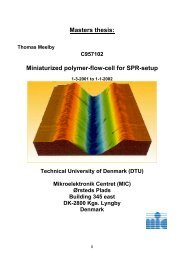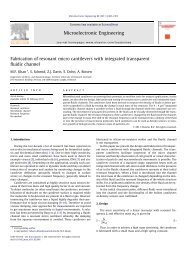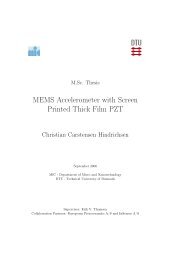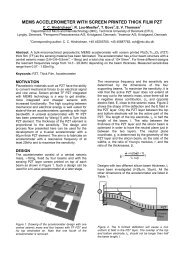Prototyping of microfluidic systems with integrated ... - DTU Nanotech
Prototyping of microfluidic systems with integrated ... - DTU Nanotech
Prototyping of microfluidic systems with integrated ... - DTU Nanotech
Create successful ePaper yourself
Turn your PDF publications into a flip-book with our unique Google optimized e-Paper software.
2.2 Fluidics and micr<strong>of</strong>luidics 9<br />
in mind are listed below, <strong>with</strong> brief comments on the importance and<br />
influence on micr<strong>of</strong>luidic flows.<br />
• Viscosity. The first parameter to be introduced is the viscosity<br />
η,which is a measure <strong>of</strong> the internal friction in a liquid. It is defined<br />
as the ratio between the shear stress and the shear rate:<br />
η = F/A<br />
dv/dy<br />
(2.1)<br />
where F is the applied force, A is the area on which the force is<br />
applied, and dv/dy is the velocity gradient perpendicular to the<br />
shear direction.<br />
The viscosity is usually temperature dependent. Often viscosity<br />
is independent <strong>of</strong> the applied shear stress, like in the case <strong>of</strong> e.g.<br />
water. These liquids are called Newtonian. In non-Newtonian<br />
liquids the viscosity changes <strong>with</strong> the shear stress. Examples <strong>of</strong><br />
such liquids are shampoo and paint, which are shear-thinning, or<br />
a mixture <strong>of</strong> corn starch and water, which is shear-thickening.<br />
• Reynolds number. The second important parameter <strong>of</strong> a liquid<br />
flow is the dimension-less Reynolds number Re. Is is defined as<br />
the ratio <strong>of</strong> the inertial forces to the viscous forces, and is defined<br />
as<br />
Re = ρdv<br />
η<br />
(2.2)<br />
where ρ is the density, d is a length scale <strong>of</strong> the system (for micr<strong>of</strong>luidic<br />
channels typically the channel cross sectional dimension),<br />
and v is the flow velocity. If the inertial forces dominate, the<br />
Reynolds number is high, and the flow is said to be turbulent. In<br />
this regime, the behavior <strong>of</strong> the flow is chaotic and stochastic,<br />
meaning that a complete description is difficult, and possible only<br />
on a statistical scale.<br />
If the viscous forces dominate, the Reynolds number is low, and the<br />
flow is called laminar. Streamlines <strong>of</strong> the flow are regular and can<br />
(mostly) be calculated. Empirical observations (in macroscopic<br />
<strong>systems</strong>) have yielded a Re value <strong>of</strong> ∼2000 – 3000 as the transition<br />
between the two flow regimes.










